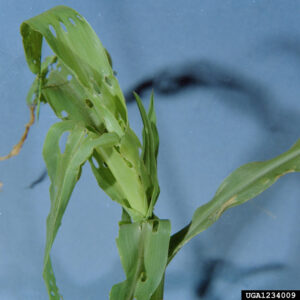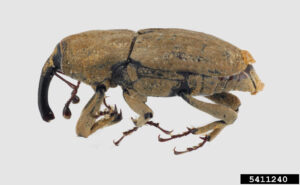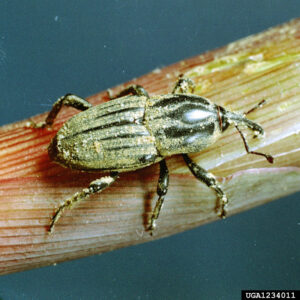- There are two major species of billbugs that injure corn, the southern corn billbug and the maize billbug.
- Billbugs can cause injury from emergence through the V6 to V8 leaf growth stages of corn.
- Both adults and grubs feed on corn stems and around roots, weakening or killing seedlings.
- Crop rotation and cultural practices that promote rapid, vigorous seedling establishment are essential elements of billbug management in corn.
- Seed-applied insecticides or banded insecticides can help limit billbug damage to corn.
Billbugs are early season insects in field corn. Southern corn billbug (SCB) can cause damage from emergence through the V6 to V8 leaf growth stages of corn in southeastern production areas. This pest damages corn over the entire Coastal Plain of the southern states and up the Mississippi River valley into the Midwest. Maize billbug (MB) is a related species that can be a problem in corn.
Billbug Injury to Corn
Corn seedlings are normally vulnerable to adult billbug damage until seedlings reach the V6 to V8 leaf stage of growth. At that time, stem diameter becomes large enough to help limit adult feeding on meristematic tissues. Seedlings attacked by billbug adults may have one or more of the following symptoms:
- Leaves with rows of holes in the blades (Figure 1).
- Feeding slits on the lower stem.
- Wilted leaves in the center of the whorl.
- Larger plants that are twisted and suckered (Figure 2).

Figure 1. Typical corn leaf injury by adult billbug.

Figure 2. Injury to corn by southern corn billbug grubs.
Picture courtesy of and used with the permission of Clemson University – USDA Cooperative Extension Slide Series, Bugwood.org.
Immature billbugs (grubs) develop within the root crown area and tunnel into the lower stalk. Plants infested with larvae often show no obvious symptoms but may be more susceptible to drought stress and die prematurely. Damage by grubs may also result in a reduced ear size of up to 40%, depending on time of infestation and other stress factors.
Billbug Identification and biology
Southern corn billbug adults are weevils with long snouts that are about ½ inch in length. They are generally ash gray or brownish in color and are usually covered with soil dust, giving the insect a soil-like color (Figure 3).
Overwintering adults emerge during April and May from litter in fields, ditches, hedgerows, and bordering woods. Adults mainly move by crawling but are capable of flight; therefore, the plants on the edge of the overwintering area are more prone to attack. However, injury to corn can occur within a mile of fields where corn was grown and infested the previous season. Weevils can be found feeding on corn stems near ground level. Females lay about 200 kidney-shaped, cream-colored eggs in holes chewed at the base of corn stems. Eggs hatch in 4 to 15 days and the legless, grub-like larvae migrate down the outside of the stem to feed in roots and tunnel into the lower stalk. The grub is cream-colored, 1/8 to 1/2 inch long (3 to 13 mm) and has a distinct reddish-brown head. Normally there is one larva per cornstalk. The grubs complete their development in 40 to 70 days and pupate (July to September) in or around the corn taproot from which they fed. Adults emerge 1 to 2 weeks after beginning pupation and seek overwintering sites.
Maize billbugs have a similar life history and biology as SCB. The MB is a reddish-brown to black snout beetle (Figure 4).

Figure 3. Southern corn billbug. Picture courtesy of and used with the permission of Anyi Mazo-Vargas, University of Puerto Rico, Bugwood.org.

Figure 4. Maize billbug. Picture courtesy of and used with the permission of Clemson University – USDA Cooperative Extension Slide Series, Bugwood.org.
The adult billbug ranges from 3/8 to 1/2 inch long (9 to 13 mm).2 The weevil hides in the soil during the day and is active at night. The MB overwinters as an adult in soil, grasses, or plant litter, becoming active about the time corn seedlings are emerging. The weevil mainly migrates to corn fields by walking but can fly 0.25 of a mile (0.40 km) or more. The adults feed at the base of the corn plant and the females lay white to gray kidney-shaped eggs about 10 days after feeding begins, in the holes they gouge in the plant stem with their mouthparts. The gouges later appear as a transverse row of punctures in the expanded leaves. A single female can lay 200 eggs or more over a two-month period. Depending on temperature, the eggs hatch in 4 to 15 days. The grubs feed and develop for several weeks in the center of stalks at ground level before moving into the soil to feed in or around the roots. Pupation occurs in the stems, roots, or soil. There is a single generation per year.
Management
Fields that have a history of billbug injury, particularly the margins of these fields, should be scouted for adult injury from seedling emergence to the V6 to V8 growth stages. The timing for scouting is critical because the window to apply an insecticide treatment is limited. Adults are more active in the early morning and evening. They usually hide underneath litter and soil during most of the day. If high numbers of billbugs are found or adult feeding injury is evident on the stem, the entire area should be sampled by walking an M or W pattern. Within the sampled area, examine 20 consecutive plants for feeding damage in 5 locations, for a total of 100 plants. If 5% of emerged seedlings are lost in a full stand of plants, an insecticide application should be considered.
Preventative management tactics that help prevent billbug infestations should be considered and include:
- Rotate corn with non-grass crops to help reduce infestations. Billbugs can become a yield-limiting problem after two or more years of continuous corn. Separating corn or sorghum crops can be used to limit billbug infestations as adults move mainly by crawling. However, they are capable of flight. Most potentially damaging infestations are found within a mile of corn grown the previous season.
- Select corn products with good early-season germination and vigor during cool, moist soil conditions.
- In fields that are expected to have billbug injury, use seed-applied insecticides or a T-band application of a soil insecticide at the highest labeled rates.
- Plant early to help corn seedlings develop sufficient size before billbugs become very active.
- Promote rapid, vigorous corn growth by optimizing soil pH and drainage and by using starter fertilizer, appropriate tillage practices to manage residue, and other practices to foster rapid corn growth.
- Control nutsedge and other hosts of billbug in and around fields to reduce feeding and reproduction.
- Over-the-top insecticide rescue treatments are difficult to time effectively.
Summary
Preventing billbug injury to corn relies on integrated management. Crop rotation and cultural practices that promote rapid and vigorous corn seedling establishment are the critical elements of the plan. Field selection is particularly important in no-till situations where early corn growth can be slow. Rapid, uniform germination and seedling growth can help 1) reduce the time that corn seedlings spend in the most sensitive growth stages for billbug feeding damage and 2) increase seedling tolerance to feeding damage. If corn will be planted in areas with high billbug infestations, a seed-applied insecticide or T-band application of an insecticide may be necessary.
